Japanese Swordguards
This page shows some of the swordguards or tsuba from the McLean Collection. Originally simple in form and design these sword accessories developed over time into miniature examples of the metalworkers art.
In June 1905 the Japan Society held a major exhibition in London on 'The Arms and Armour of Old Japan'. The exhibition was one of the largest on that subject to have been seen at that time. Experts from Europe and Japan contributed to the exhibition catalogue and it became an early landmark in the wider dispersal of knowledge on Japanese arms. The catalogue entry on tsuba reamins one of the best introductions to the subject.
'Although there is considerable range of shape amongst tsuba, the prevalent form in a general collection will be found to be a short ellipse; but many specimens, especially those of an early date, present an exactly circular outline. The remaining shapes, with a few exceptions to be presently noted, may be described as rounded oblong, barrel shaped, square, octagonal, diamond shaped, four-lobed (Mokko), and four-cusped (Aoi). There exist also a number of guards the outlines of which have been determined by the form of their decorative elements - such as a group of fans, a pair of butterflies or a branch of a flowering tree. A few guards occur having a pentagonal, hexagonal or heptagonal outline. A more or less irregular or undulatory edge is not uncommon. Sometimes the edge is beaded, pierced or ornamented with reliefs.'
From 'Arms and Armour of Old Japan' by Professor A.H. Church 1905.
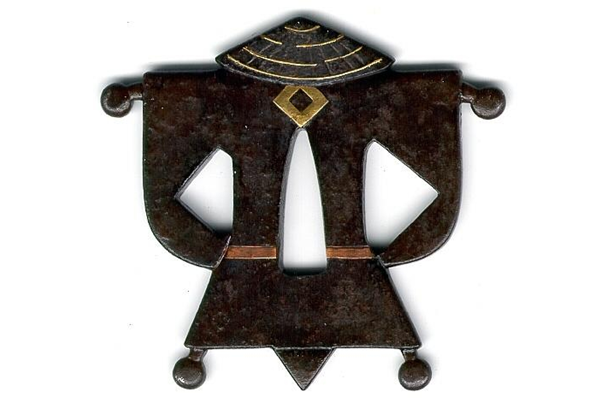
An eighteenth century Japanese swordguard or tsuba
An eighteenth century Japanese swordguard or tsuba by Shigeyoshi Umetada. The tsuba is in the form of a kimono rack. - 1981.134 © McLean Museum and Art Gallery, Greenock
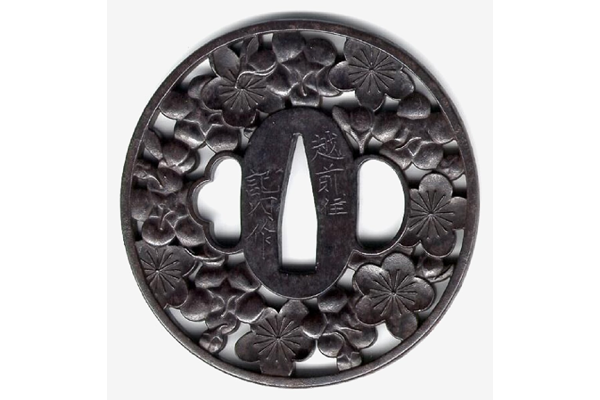
An eighteenth century Japanese swordguard or tsuba
An eighteenth century Japanese swordguard or tsuba in an openwork design of cherry blossoms. Made by Saku Kinai of Echizen - 1981.54 - © McLean Museum and Art Gallery, Greenock
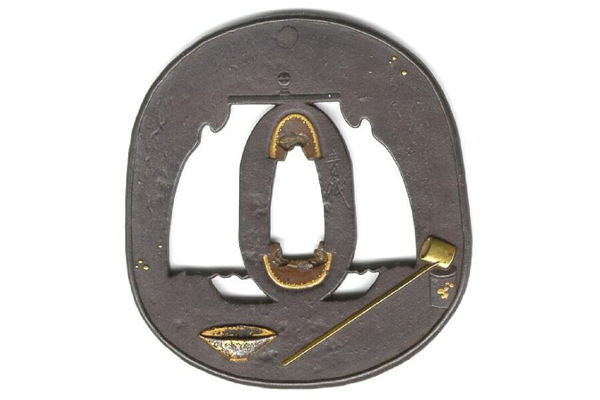
A eighteenth century Japanese swordguard or tsuba
A eighteenth century Japanese swordguard or tsuba in an openwork design of the utensils for the tea ceremony with gilding, inlays and inscription on both faces. - 1981.59 - © McLean Museum and Art Gallery, Greenock
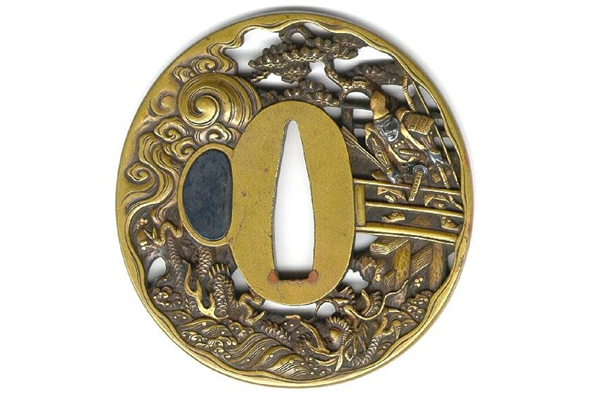
A Japanese swordguard or tsuba, date unknown
A Japanese swordguard or tsuba, date unknown, with a design of a storm dragon and waves with a samurai on a bridge looking down on the scene. - 1981.61 - © McLean Museum and Art Gallery, Greenock

A Japanese swordguard or tsuba, date unknown
A Japanese swordguard or tsuba, date unknown. It has an archaic design of dragons and Greek fret, in relief and inlaid with precious metals. One side of the tsuba is decorated with bonji figures, carved and gilded. - 1981.62 - © McLean Museum and Art Gallery, Greenock
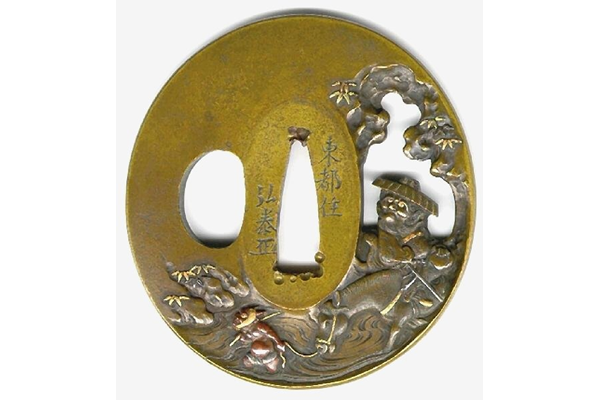
An eighteenth century Japanese swordguard or tsuba
An eighteenth century Japanese swordguard or tsuba. Its is made of yellow bronze and is decorated with a scene sowing an elderly figure following a bullock being led across a river by an oni. Signed by Hiroyasu. - 1981.65 - © McLean Museum and Art Gallery, Greenock
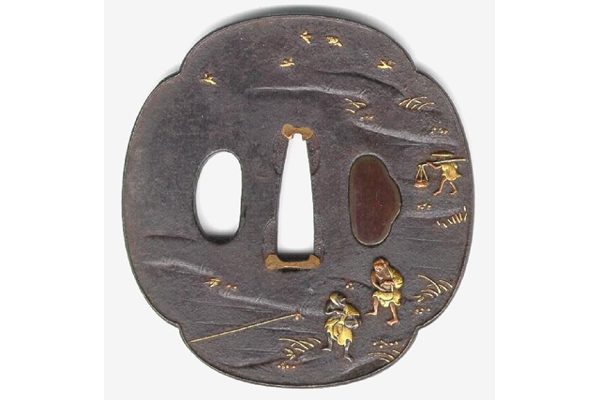
A eighteenth century Japanese swordguard or tsuba
A eighteenth century Japanese swordguard or tsuba. The design shows a landscape with two men, in shakudo and gold, sowing rice, one in the distance with pannier and yoke. - 1981.71 - © McLean Museum and Art Gallery, Greenock
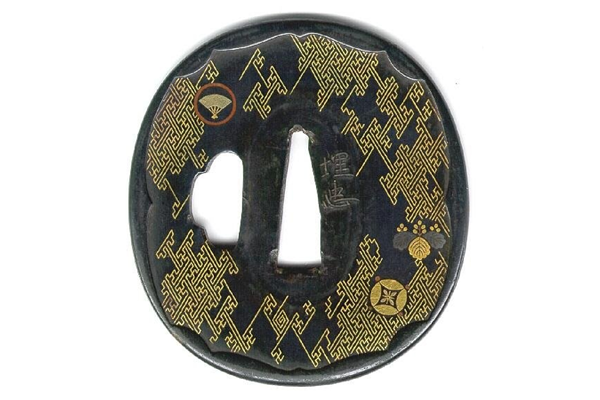
A Japanese swordguard or tsuba, date unknown
A Japanese swordguard or tsuba, date unknown. The design shows a gilded saya pattern with mons and swastikas including flowers and the Kiri mon and leaves. - 1981.80 - © McLean Museum and Art Gallery, Greenock

An early nineteenth century Japanese swordguard or tsuba
An early nineteenth century Japanese swordguard or tsuba. The design shows Mount Fuji and a storm dragon in relief and inlaid with gold and silver. Made by Sasagama Tokuhiro. - 1981.81 - © McLean Museum and Art Gallery, Greenock
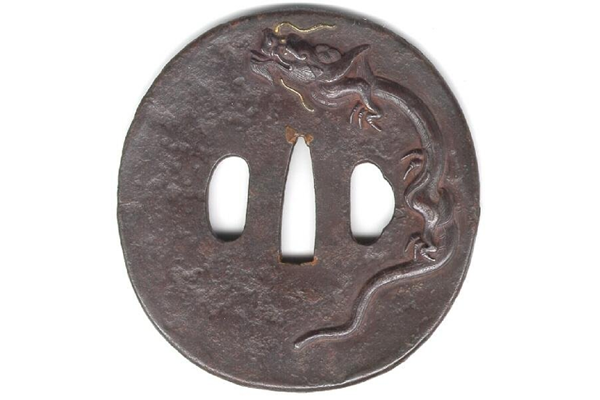
A seventeenth century Japanese swordguard or tsuba
A seventeenth century Japanese swordguard or tsuba. The design has a hammered surface with a rain dragon carved in relief with gilding. - 1981.91 - © McLean Museum and Art Gallery, Greenock
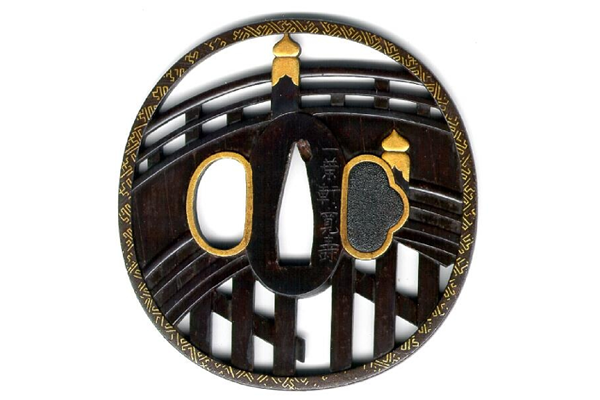
A eighteenth century Japanese swordguard or tsuba
A eighteenth century Japanese swordguard or tsuba. The design is in openwork and shows the sacred bridge with saya border pattern (gilded) engraved with gold inlays. The inlays are signed 'Shoyetsu a pupil of Goto Seijo.' The tsuba is signed: 'Ichyo-ken Kuanju.' - 1981.96 - © McLean Museum and Art Gallery, Greenock
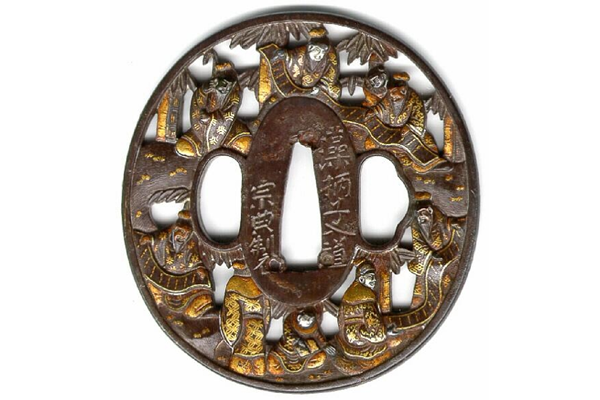
A eighteenth century Japanese swordguard or tsuba
A eighteenth century Japanese swordguard or tsuba. The design shows a scene depicting the Seven Sages of the Bamboo Grove in openwork. Inscription on both sides. Signed: Soten of Hikone. - 1981.99 - © McLean Museum and Art Gallery, Greenock
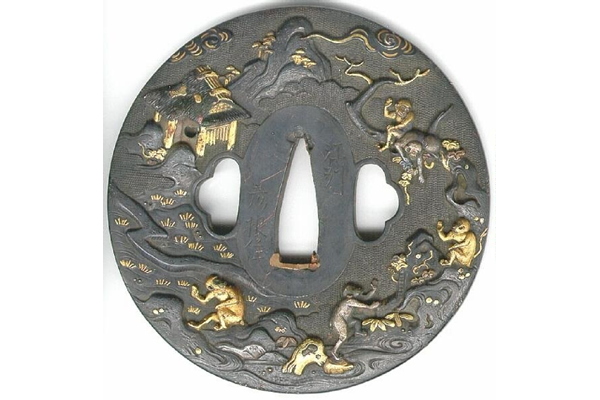
A eighteenth century Japanese swordguard or tsuba
A eighteenth century Japanese swordguard or tsuba. The design shows a legendary subject featuring a dragon and a waterfall. The reverse shows numerous monkeys on rocks and trees and a hut. Signed by Nomura Hokio of Hikone - 1981.104 - © McLean Museum and Art Gallery, Greenock
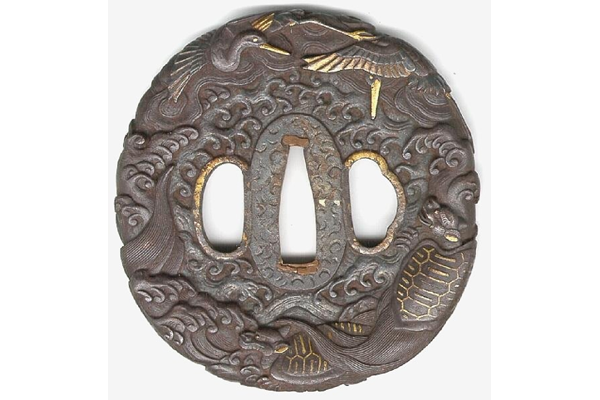
A Japanese swordguard or tsuba, date unknown
A Japanese swordguard or tsuba, date unknown. The design shows a central area of turbulent waves with storks and the giant hairy tailed tortoise on the rim. - 1981.107 - © McLean Museum and Art Gallery, Greenock

A late nineteenth century Japanese swordguard or tsuba
A late nineteenth century Japanese swordguard or tsuba. The open work design shows a landscape with castle, pagodas, bridge etc. with much gilding and several inlays. - 1981.108 - © McLean Museum and Art Gallery, Greenock
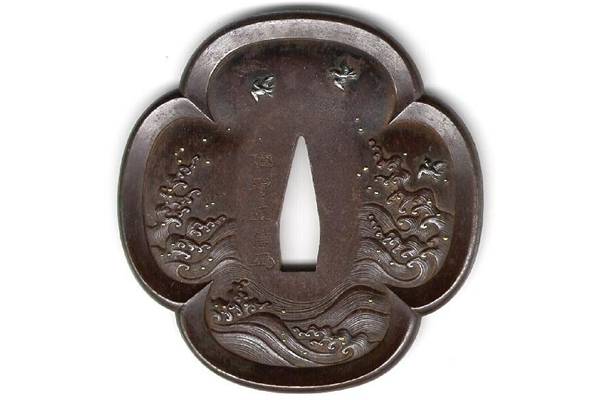
A eighteenth century Japanese swordguard or tsuba
A eighteenth century Japanese swordguard or tsuba. The design shows turbulent water with birds in flight, carved in relief and inlaid in gold and silver. Signed: Nawonobu Takeno. - 1981.113 - © McLean Museum and Art Gallery, Greenock

A very late nineteenth century Japanese swordguard or tsuba
A very late nineteenth century Japanese swordguard or tsuba. The design shows maple leaves and cherry blossoms in relief and inlaid with precious metals. Dated 1900. Signed: Tomotsune. - 1981.129 - © McLean Museum and Art Gallery, Greenock

A Japanese swordguard or tsuba, date unknown
A Japanese swordguard or tsuba, date unknown. The design features a border of archaic letters & symbols inlaid in silver around the rim. The centre has a gilded and carved design of a dragon. - 1981.143 - © McLean Museum and Art Gallery, Greenock
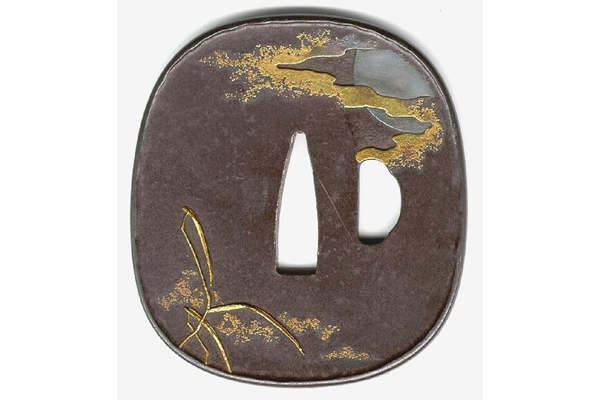
A Japanese swordguard or tsuba, date unknown
A Japanese swordguard or tsuba, date unknown. The design on this face shows a plant stalk, the moon and cloud forms. - 1981.146 - © McLean Museum and Art Gallery, Greenock
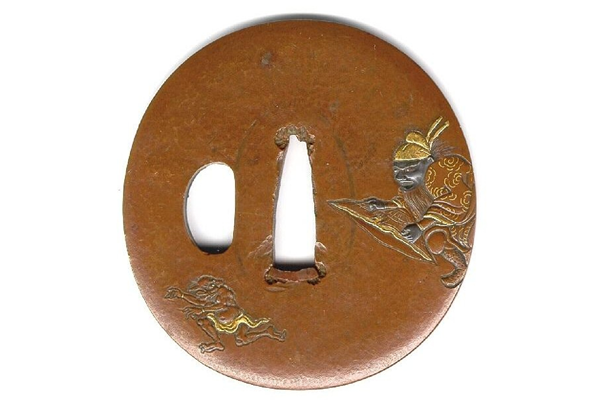
A eighteenth century Edo period Japanese swordguard or tsuba
A eighteenth century Edo period Japanese swordguard or tsuba. The design shows Shoki the demon slayer pursuing a demon. Decorated with inlays and gilding. - 1981.150 - © McLean Museum and Art Gallery, Greenock
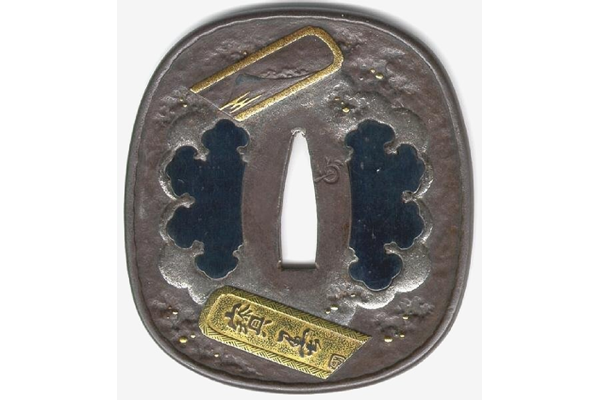
A Japanese swordguard or tsuba, date unknown
A Japanese swordguard or tsuba, date unknown. The design shows broken ink cakes on both sides. this face shows the cakes decorated with Mount Fuji and bearing an inscription. - 1981.155 - © McLean Museum and Art Gallery, Greenock

A Japanese swordguard or tsuba, date unknown
A Japanese swordguard or tsuba, date unknown. On both faces there is a floral design. One face shows an animal, possibly a dragon, and a fox. The edge of the tsuba is gilded. - 1981.158 - © McLean Museum and Art Gallery, Greenock

A Japanese swordguard or tsuba, date unknown
A Japanese swordguard or tsuba, date unknown. The design shows a farmer with a bullock led by a boy with a crane in flight above. - 1981.157 - © McLean Museum and Art Gallery, Greenock

A Japanese swordguard or tsuba, date unknown
A Japanese swordguard or tsuba, date unknown. The design shows Soki and an attendant under a pine tree with a waterfall. Inscription on both sides. The rim of the tsuba is gilded. - 1981.1156 - © McLean Museum and Art Gallery, Greenock

A eighteenth century Edo period Japanese swordguard or tsuba
A eighteenth century Edo period Japanese swordguard or tsuba. The design shows the rim as a bamboo frame with a design of leaves with inlays & gilding on both faces. Signed: Yasuchika. - 1981.142 - © McLean Museum and Art Gallery, Greenock
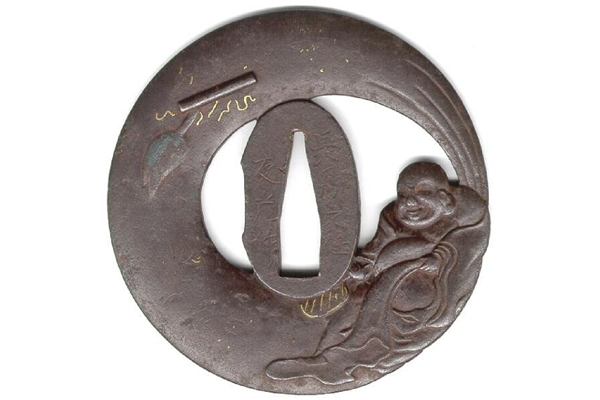
A eighteenth century Japanese swordguard or tsuba
A eighteenth century Japanese swordguard or tsuba. The design shows Hotei Osho with his treasure bag in relief casting and openwork. Decorated with gold and silver inlays. Signed: Tomomitsu. - 1981.125 - © McLean Museum and Art Gallery, Greenock
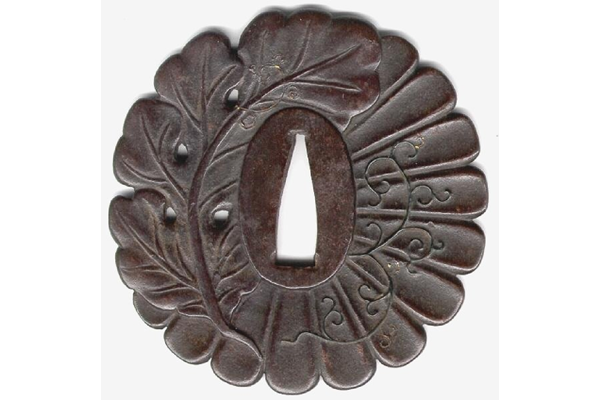
A Japanese swordguard or tsuba, date unknown
A Japanese swordguard or tsuba, date unknown. the circular form is in the shape of a chrysanthemum leaf and vine carved on both faces with gilding. - 1981.105 - © McLean Museum and Art Gallery, Greenock
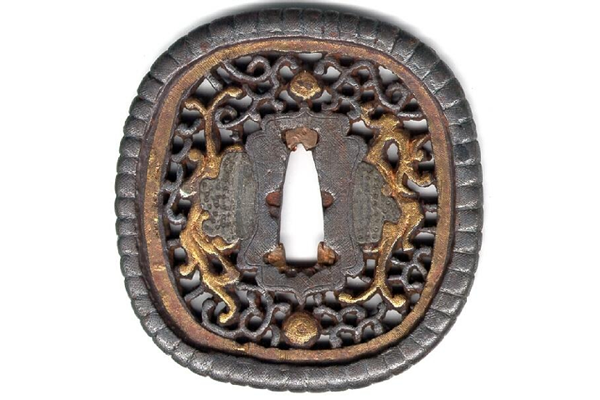
A seventeenth century Japanese swordguard or tsuba
A seventeenth century Japanese swordguard or tsuba. The tsuba is made of iron and has a damascened design in gold and silver based on the Karakusa pattern. - 1981.116 - © McLean Museum and Art Gallery, Greenock



























